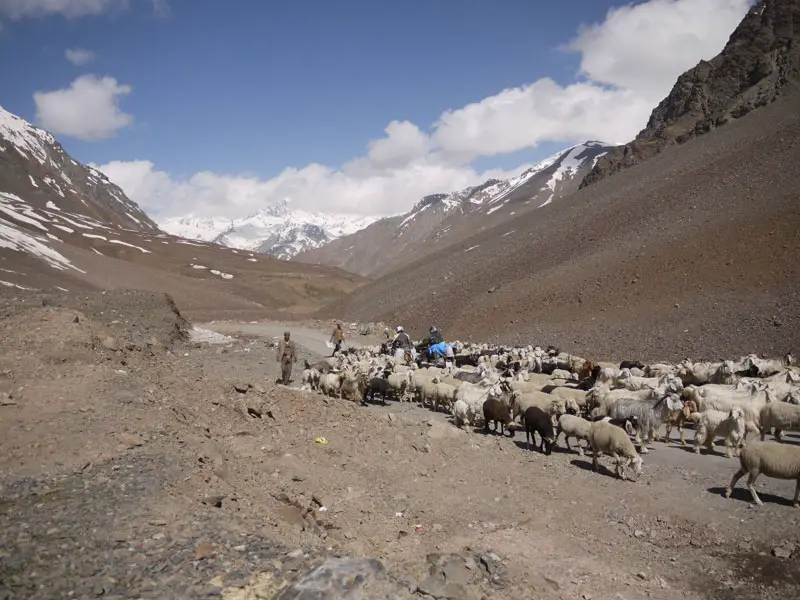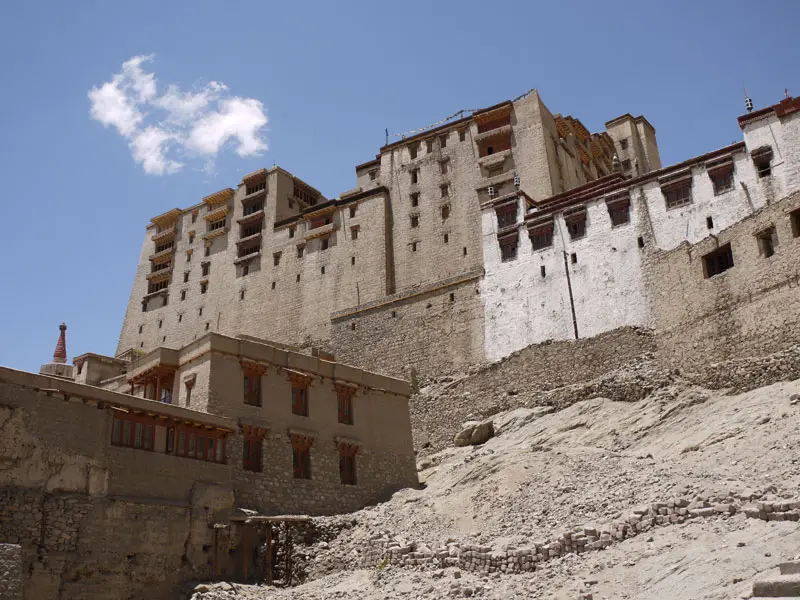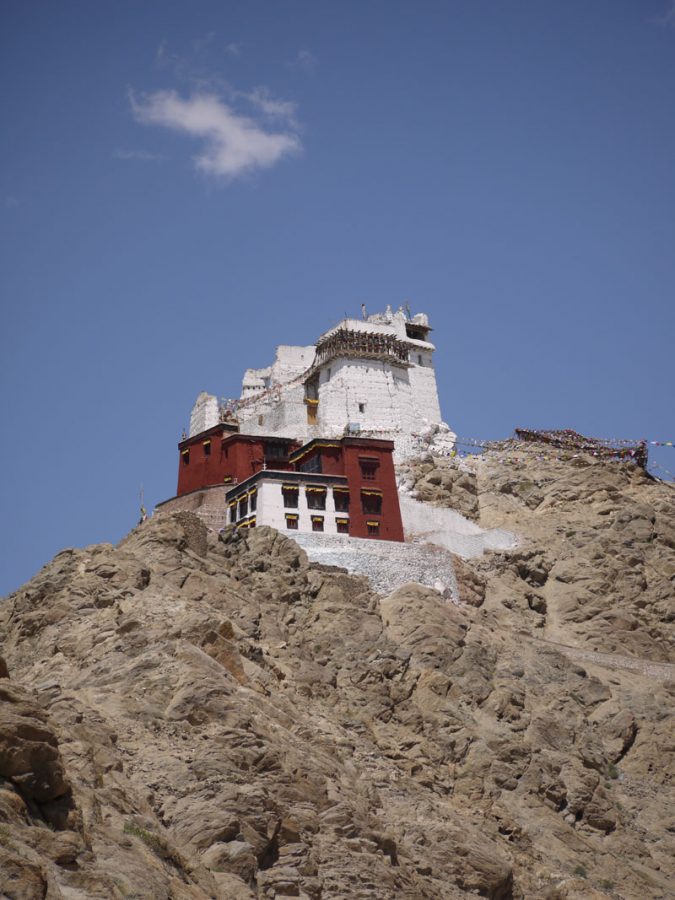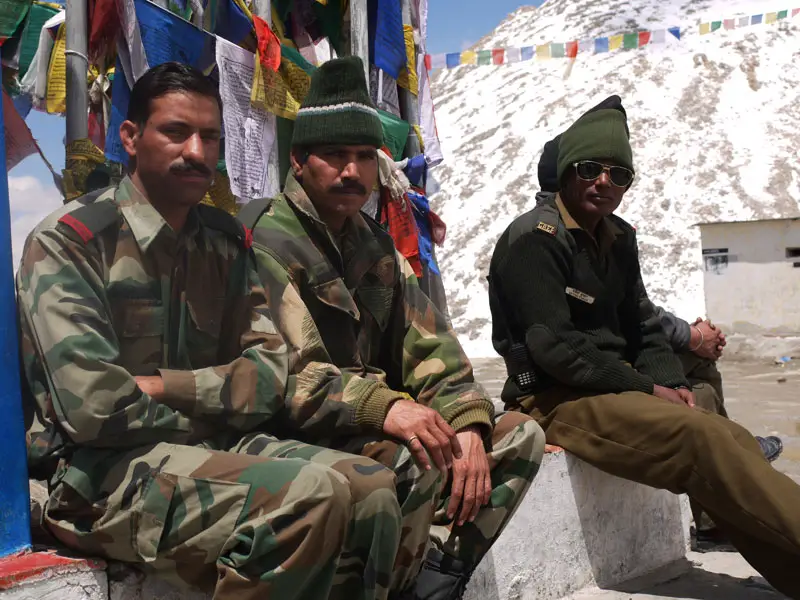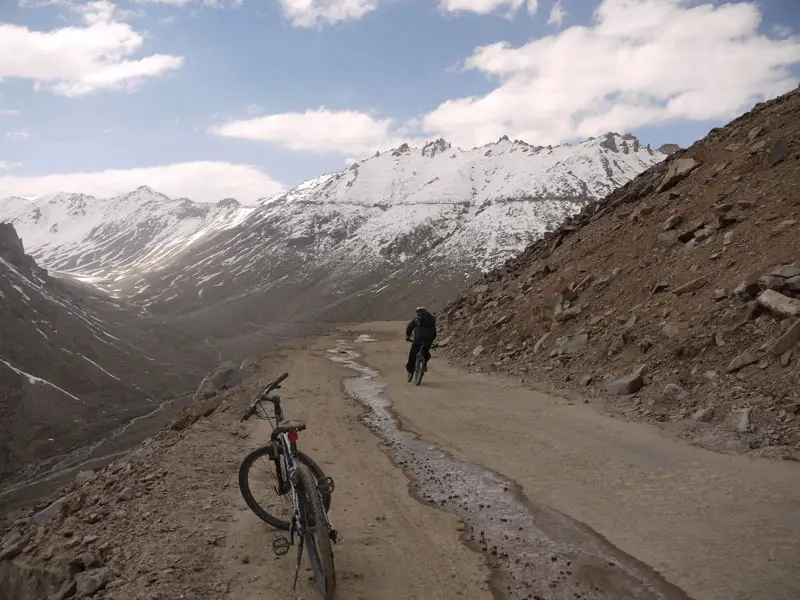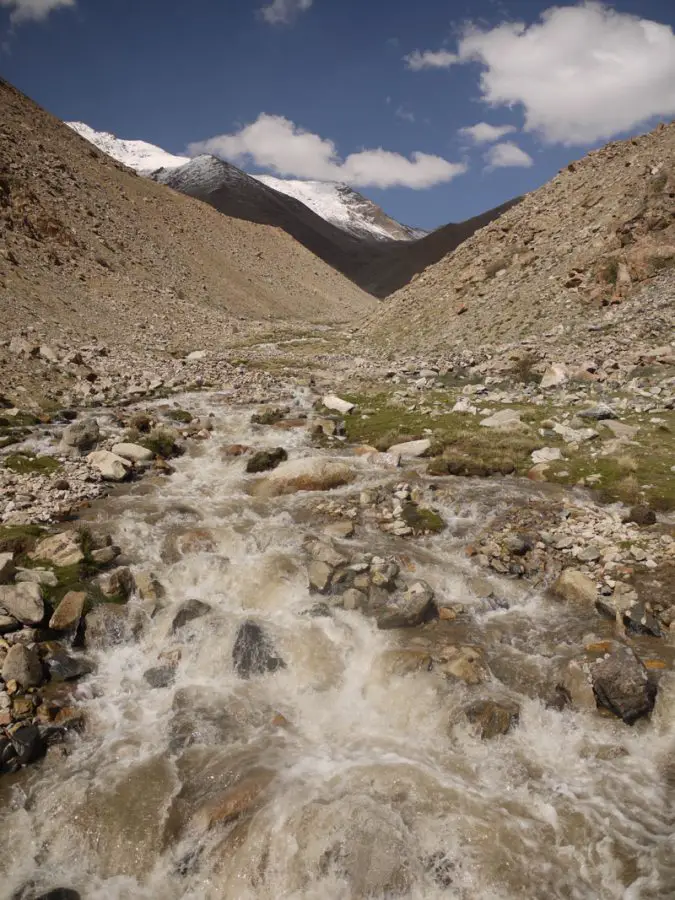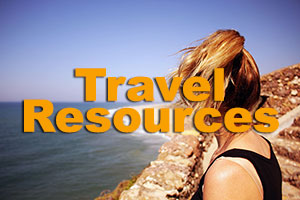The drive from Manali to Leh Ladakh was very long but the scenery driving through Ladak was just incredible. The trip took a total of nineteen hours and the road took us over a total of five different road passes; Rohtang La (3,978 meters), Baralacha La (4,9550 meters), Nakila Pass ( 4,915 meters), Lachlung La (5,060 meters) and Taglang La (5,359 meters). The journey didn’t include any overnight stop but we did stop at makeshift ‘parachute cafes’ for rest stops along the way. These round, white tents were in the middle of nowhere and were run by semi-nomadic people who made their money selling snacks to passing motorists from June to late September, the only months of the year that the road is open. Looking out the windows, we made our way along the winding mountain roads, admiring the barren, rocky, isolated landscape of Ladakh. The terrain had changed dramatically from the alpine feel of the mountains in Himachal Pradesh, what was in front of us now was like looking at the surface of Mars, the rocky mountains had a distinct red-brown tinge off them and they lit up dramatically when the sunlight hit them. The long haul to Leh Ladakh continued through the mountainous desert eventually reaching the hugely Tibetan influenced city of Leh.
Driving into Leh Ladakh our eye was immediately drawn to the Leh Palace and the 16th century Tsemo fort perched high above the town on palace ridge. These magnificent buildings can be seen from virtually everywhere in Leh and while one day they were the focal point of life in Leh, nowadays they are simply amazing viewpoints and tourist attractions. Walking up the narrow streets to the east of the main town the winding paths took you up the side of the large, very square, communist looking building which was the Leh palace. Inside they are still renovating the building. Exploring the dark corridors of the palace, climbing rickety ladders and negotiating holes in the floor we came across some very old Buddhist statues and eventually found ourselves on the roof of the building looking down across the rooftops of the town and into the barren valley beyond. The fort was a steep climb a further fifteen minutes up a stony path. White-washed walls enclosed a small gompa at the foot of the fort and inside were some powerful Buddhist deity statues which depicted the figures with rings of flame around them, extra limbs, sporting weapons, chains of human skulls, extra heads and faces and often standing on corpses. Each statue had it’s face covered with a kind of veil so it wasn’t visible to viewers. Another room housed an eight meter tall gold-faced Maitreya which sat ‘western-style’ indicating the coming of a future Buddha. The walk back down the other side of palace ridge took us through a collection of ancient white stupas, known as the forest of stupas, they were scattered everywhere in various sizes and in varying condition also.
Leh is quite a laid-back place, the town’s streets are packed with monks in maroon robes going about their daily business. The Cowkhang Gompa (monastery) is in the centre of town and in the areas just outside of the main town are a collection of other monasteries all home to studying Buddhist monks. As well as the huge Buddhist population, a large proportion of people in Leh and indeed in the northern provinces of Jammu and Kashmir are Muslim due to it’s proximity to Pakistan. This makes for a vast contrast to the rest of India which is primarily Hindu, followed closely by Islamic, then Christian and the fourth most popular faith is Buddhism. The surrounding white peaks, the huge valleys and the remote, isolated location all together make Leh a very unique and relaxed place to visit.
However, the military presence in this part of India cannot be ignored. The northern provinces of Kashmir and Ladakh share borders with Pakistan, Afghanistan, China and Tibet. Leh Ladakh can be reached by road for only four months of the year and is therefore extremely isolated from the rest of India. An ongoing military presence is necessary here to monitor the borders and visitor’s passports are checked multiple times on the drive north from Manali and east from Sriniagar to keep security tight in this remote area of the country. Army jeeps, armed soldiers and huge army trucks are constantly moving around Leh’s streets and school buses are driven by soldiers and have wire cages around the windows to protect the young passengers inside.While it’s a relaxing place to visit from a tourist’s point of view there was no doubt in our mind that at times it may not be as relaxing for the locals but life goes on regardless.
A two-hour drive beyond Leh at an altitude of 5,602 metres is the Khardung La, the highest motorable road pass in the world. We drove up the steep winding roads taking in the mind-blowing views throughout the journey. We had to stop to show our passports at one of the military checkpoints along the way before continuing all the way to the top of the pass. In the back of one of the jeeps our mountain bikes were strapped in and we were buzzing with excitement at the thoughts of racing back 38km on the steep roads to Leh, dropping just over 2,000 meters in altitude! At the top of the Khardung La there was snow everywhere and the temperature had dropped significantly. A small shrine with both Buddhist and Hindu symbology painted on the roof, the world’s highest souvenir shop, the world’s highest cafe and a small army presence was all that existed at the top of the pass. The road leveled off briefly between tall mounds of snow for not even a hundred metres before dropping steeply down the other side into the Nubra Valley to the north. After a quick masala chai to warm up, the gloves were on, helmets donned and we set out on the road back to Leh. Riding down the mountainside was an amazing experience, we were flying along the rocky unpaved road, whipping around corners at full speed and holding on for dear life for the bone rattling descent. After some time, the road got better and with the tarmac flying by beneath our wheels the ride was easier and less bone rattling but a whole lot faster. Cars and trucks passed occasionally coming against us but we were moving much quicker than any other vehicle going downhill, the rush was something else and arriving back into Leh all I wanted to do was saddle up and do it all again.
Pangong Tso is a huge lake to the east of Leh which straddles the border between India and China. We had a motorbike organised for the journey out there for the next day. After that, Srinagar in Kashmir, 500km west of Leh would be our next destination and with a bus seat booked for the epic seventeen hour trip, we had one more day in Leh soaking up the remote landscape and Buddhist culture before we had to check out of our room and move on. Being in Leh and Ladakh was like leaving India for a few days and moving to Tibet but with our time limited it was time to get back to India and the capital of Kashmir, Srinagar.

Brian is a travel writer, photographer, blogger, travel addict and adventure-junkie. Being outdoors, getting off the beaten track and outside his comfort zone is what makes him tick. Brian’s the dreamer in the relationship; when he’s not travelling, he’s dreaming about it! Keeping fit, cooking, music and red wine take up the rest of his time.
Sign up for our free travel photography Ebook "Faces of Nepal" and you'll also receive our monthly newsletter.

